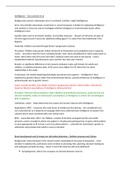Intelligence – Van Leeuwen et al
Background: parents’ phenotypes aren’t correlated, Gardner’s eight intelligences
Aims: Test whether phenotypic assortment or social homogamy is better for explaining intelligence
and variation in IQ scores and to investigate whether biological or environmental factors affect
intelligence more
Sample: letter sent to 214 Dutch families, 112 families took part – 48 pairs of MZ twins, 64 pairs of
DZ twins aged around 9 years old, additional sibling aged 9-14, taken from the Netherlands Twin
Registry
Materials: Children assessed through Raven’s progressive matrices
Procedure: Children and parents visited University of Amsterdam and completed tests in separate
rooms – procedure took five hours including breaks. Twin status established by cheek swabs taken at
home, which were sent off to the university’s medical centre and used to see zyosity – used a
standardised method. Questionnaires were used for two twin pairs instead
Results: no significant differences in IQ measures between males and females for adults and
children, correlations between pairs of IQ scores were higher for MZ twins than for other
relationships in the study
Conclusions: the model explaining phenotypic assortment was superior – intelligence is best
explained by genetic effects rather than environmental factors, parental influences of intelligence is
predominantly due to genetic factors
Issues: socially sensitive, low validity in Raven’s progressive matrices, deterministic, reductionist,
based on Western assumptions of intelligence (ethnocentrism)
Strengths: followed ethical guidelines, high reliability (standardised procedures), good internal and
external reliability, makes no ethnocentric assumptions as intelligence is culture-fair and biological,
RPM is objective
Usefulness: useful – helps determine how nature and nurture interact with intelligence
Applications: WISC – measures five main forms of intellectual functioning – not considered to be
very culturally fair as it depends on language skills (may underestimate intelligence of people from
cultures which value nonverbal skills over verbal ones)
RPM – nonverbal tests, SPM = for children, consists of 60 items arranged into five sets which
presents a series of patterns where one pattern is missing and participant has to guess which pattern
is more appropriate to fit in from a set of six other patterns – culturally fair (nonverbal), quicker to
administer and provides data which is easy to interpret
Brain development and its impact on risk-taking behaviour – Barkley-Levenson and Galvan
Background: ventral striatum is the reward system responding to increases in dopamine – more
sensitive in adolescents, prefrontal cortex is linked to assessing risks, planning, decision-making etc
and undergoes synaptic pruning – doesn’t reach full maturity until early adulthood
Synaptogenisis: where new synapses are formed between neurons
, Synaptic pruning: where inactive synapses die off while neurons used most often become
stronger
Myelination: the formation of myelin around the axon of a neuron
Aims: test three hypotheses – adolescents would be more sensitive than adults to increased EV
(expected value), adolescents would show greater VS activation as EV increased compared to adults,
adolescents would still show a heightened VS response even after matching with adults on number
of gambles accepted
Method: laboratory-based quasi experiment – IV: whether participants were an adult or adolescent,
independent measures design
Sample: 19 adults aged 25-30 (8 males, 11 females), 22 adolescents aged 13-17 (11 males, 11
females), all right-handed, recruited by self-selected sampling through posters and online
Apparatus: fMRI scans, 140 functional and 2 structural images were taken per participant
Procedure: participants visited lab on two occasions – intake sessions and again around 1 week later
for an fMRI session
Intake session: adults gave informed consent and adolescents’ informed consent was
provided by parents on their behalf, ppts given details of monthly spending money and
where it came from, ppts each given $20 at the end of the session to use as playing money
and were told they could win another $20 but could also lose the $20 they had to give ppts a
sense of ownership over the money
fMRI session: ppts each completed a gambling task – a spinner was shown divided into two
halves, where each half presented an amount of money in whole dollars between $5-$20 –
one half showed possible gain and other half showed possible loss, which side showed the
gain and losses counterbalanced across all participants
192 trials – on 24 trials the gamble was manipulated so the outcome could only be a
gain, on another 24 trials the gamble was manipulated so the outcome could only be
a loss (randomly distributed), EVs of gain only trials was +$6 to +$19 and loss only
trials was -$6 to -$19
Participants decided on whether they would be prepared to accept the gamble for
real money – they were told that a random trial would be played for money, which
would be added or taken from their payment of participation
Results: increased EV made an acceptance of a gamble more likely (significantly greater for
adolescents), as EV increased adolescents showed greater activation in the VS than adults
Conclusions: the adolescent brain shows a heightened sensitivity to rewards, adolescent brain places
greater value on potential rewards than the adult brain
Issues: small sample would be difficult to generalise from, lacked pre-adolescent group so would be
impossible to say whether this only occurred in adolescents, time-consuming, scanning may have
caused participants discomfort, gambling task may have encouraged gambling behaviours outside of
the study, low ecological validity, ethnocentric (Western view of adolescents)
Strengths: high internal reliability (extraneous variables controlled), high reliability (standardised
procedures), high external reliability (allows replication by other researchers)




